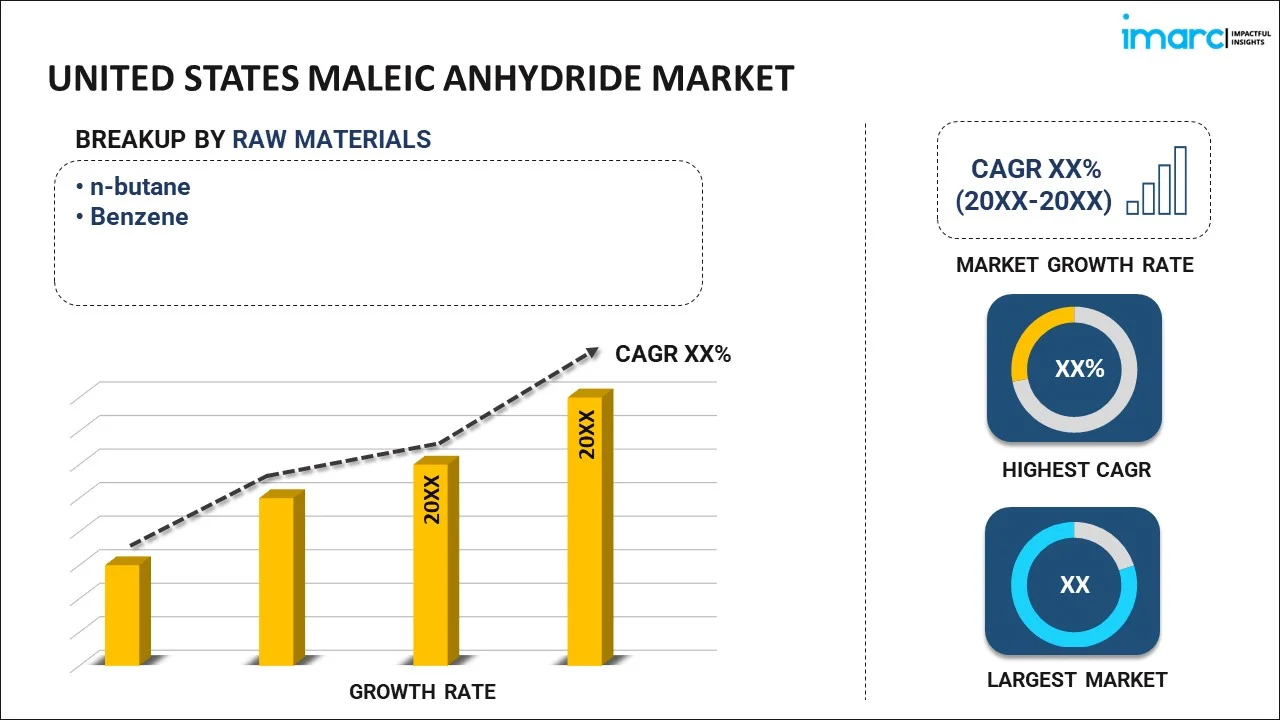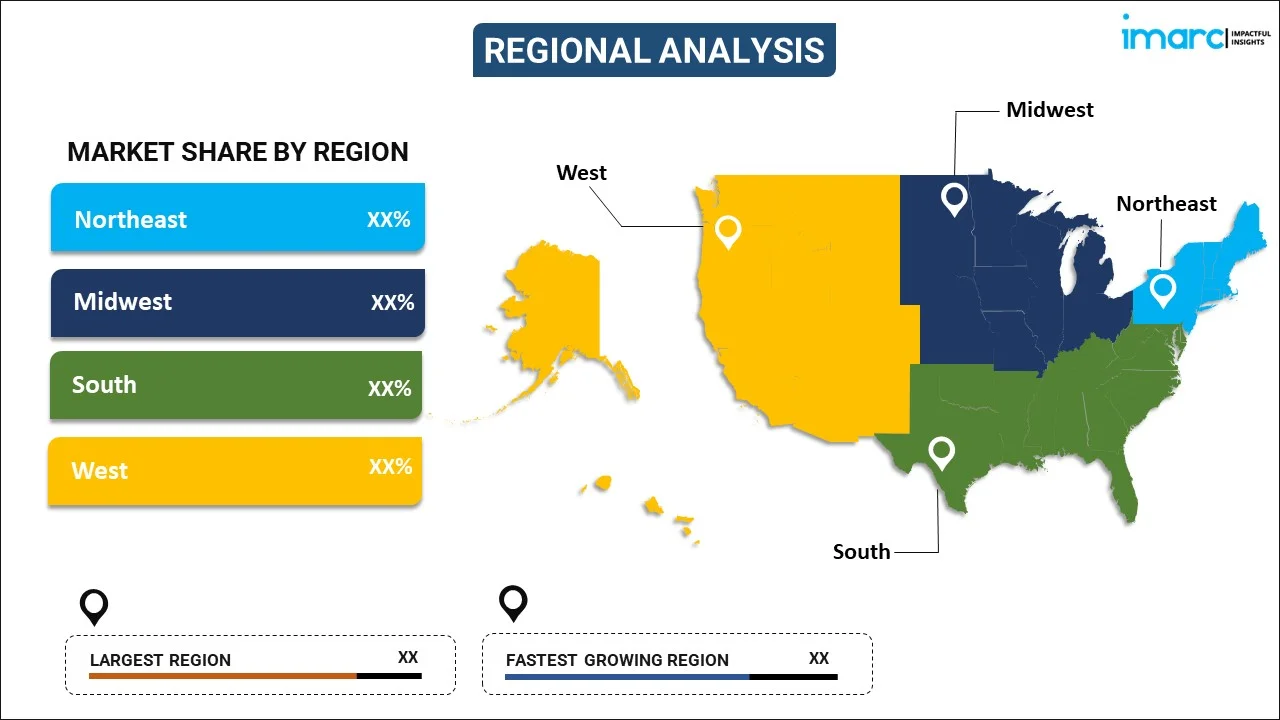
United States Maleic Anhydride Market Report by Raw Material (n-butane, Benzene), Application (Unsaturated Polyester Resin (UPR), 1-4, Butanediol (BDO), Additives, Copolymers, and Others), End Use Industry (Construction, Automobile, Food and Beverage, Oil Products, Electronics, Personal Care, Pharmaceuticals, and Others), and Region 2025-2033
Market Overview:
United States maleic anhydride market size reached USD 839 Million in 2024. Looking forward, IMARC Group expects the market to reach USD 1,530 Million by 2033, exhibiting a growth rate (CAGR) of 6.9% during 2025-2033. The increasing demand for unsaturated polyester resins in the construction and automotive sectors, expanding applications in copolymer synthesis, and rising use in agricultural chemicals, pharmaceuticals, adhesives, and bio-based production initiatives represent some of the key factors driving the market.
|
Report Attribute
|
Key Statistics
|
|---|---|
|
Base Year
|
2024 |
|
Forecast Years
|
2025-2033
|
|
Historical Years
|
2019-2024
|
| Market Size in 2024 | USD 839 Million |
| Market Forecast in 2033 | USD 1,530 Million |
| Market Growth Rate (2025-2033) | 6.9% |
Maleic anhydride is an organic compound that appears as white crystalline needles or flakes at room temperature. It is produced industrially through the oxidation of benzene or butane. This compound is a highly versatile chemical used in the synthesis of various products. One of its primary applications is in the production of unsaturated polyester resins, which are crucial in the manufacturing of fiberglass-reinforced plastics commonly used in construction, automotive, and marine industries. Maleic anhydride is also employed in the synthesis of agricultural chemicals, pharmaceuticals, and surfactants. Owing to its ability to undergo reactions with a variety of compounds, it serves as a key intermediate in the synthesis of copolymers, providing enhanced properties to the resulting materials. Additionally, maleic anhydride is used as a cross-linking agent in the production of certain adhesives and as a component in the manufacturing of paper-sizing agents. Its diverse applications make maleic anhydride a significant compound in the chemical industry with broad-reaching impacts on various sectors.
United States Maleic Anhydride Market Trends:
The increasing demand for unsaturated polyester resins, a key derivative of maleic anhydride, in the thriving construction and automotive industries represents one of the key factors influencing the market growth. In line with this, the resilience and durability of fiberglass-reinforced plastics produced using these resins contribute to their widespread use, creating a favorable outlook for the maleic anhydride market. Moreover, rapid urbanization and expanding infrastructural development are further fueling the demand for these materials, thereby strengthening the market growth. In confluence with this, the rising consumption of maleic anhydride in the synthesis of copolymers, especially in the production of water-soluble polymers used in various industrial processes, is contributing to the market expansion. Concurrently, the extensive product utilization in the production of agricultural chemicals, such as herbicides, insecticides, and fungicides, is fueling market growth, given the surging global need to support food production. Additionally, the pharmaceutical industry's reliance on maleic anhydride for the production of certain medications and drug delivery systems is acting as another growth-inducing factor. Besides this, the widespread product adoption across the adhesive industry as a cross-linking agent, enhancing the performance of adhesives in various applications, is providing an impetus to the market growth. Furthermore, the compound's role in the synthesis of surfactants, which find applications in detergents, emulsifiers, and personal care products, is presenting lucrative opportunities for market expansion. Apart from this, the growing emphasis on sustainability and bio-based products has led to increased research and development (R&D) in bio-based maleic anhydride production, propelling the market forward.
United States Maleic Anhydride Market Segmentation:
IMARC Group provides an analysis of the key trends in each segment of the market, along with forecasts at the country level for 2025-2033. Our report has categorized the market based on raw material, application, and end use industry.
Raw Material Insights:

- n-butane
- Benzene
The report has provided a detailed breakup and analysis of the market based on the raw material. This includes n-butane and benzene.
Application Insights:
- Unsaturated Polyester Resin (UPR)
- 1-4, Butanediol (BDO)
- Additives
- Copolymers
- Others
A detailed breakup and analysis of the market based on the application have also been provided in the report. This includes unsaturated polyester resin (UPR), 1-4, butanediol (BDO), additives, copolymers, and others.
End Use Industry Insights:
- Construction
- Automobile
- Food and Beverage
- Oil Products
- Electronics
- Personal Care
- Pharmaceuticals
- Others
The report has provided a detailed breakup and analysis of the market based on the end use industry. This includes construction, automobile, food and beverage, oil products, electronics, personal care, pharmaceuticals, and others.
Regional Insights:

- Northeast
- Midwest
- South
- West
The report has also provided a comprehensive analysis of all the major regional markets, which include Northeast, Midwest, South, and West.
Competitive Landscape:
The market research report has also provided a comprehensive analysis of the competitive landscape in the market. Competitive analysis such as market structure, key player positioning, top winning strategies, competitive dashboard, and company evaluation quadrant has been covered in the report. Also, detailed profiles of all major companies have been provided.
United States Maleic Anhydride Market Report Coverage:
| Report Features | Details |
|---|---|
| Base Year of the Analysis | 2024 |
| Historical Period | 2019-2024 |
| Forecast Period | 2025-2033 |
| Units | Million USD |
| Scope of the Report | Exploration of Historical and Forecast Trends, Industry Catalysts and Challenges, Segment-Wise Historical and Predictive Market Assessment:
|
| Raw Materials Covered | -butane, Benzene |
| Applications Covered | Unsaturated Polyester Resin (UPR), 1-4, Butanediol (BDO), Additives, Copolymers, Others |
| End Use Industries Covered | Construction, Automobile, Food and Beverage, Oil Products, Electronics, Personal Care, Pharmaceuticals, Others |
| Regions Covered | Northeast, Midwest, South, West |
| Customization Scope | 10% Free Customization |
|
Post-Sale Analyst Support |
10-12 Weeks |
| Delivery Format | PDF and Excel through Email (We can also provide the editable version of the report in PPT/Word format on special request) |
Key Questions Answered in This Report:
- How has the United States maleic anhydride market performed so far and how will it perform in the coming years?
- What has been the impact of COVID-19 on the United States maleic anhydride market?
- What is the breakup of the United States maleic anhydride market on the basis of raw material?
- What is the breakup of the United States maleic anhydride market on the basis of application?
- What is the breakup of the United States maleic anhydride market on the basis of end use industry?
- What are the various stages in the value chain of the United States maleic anhydride market?
- What are the key driving factors and challenges in the United States maleic anhydride?
- What is the structure of the United States maleic anhydride market and who are the key players?
- What is the degree of competition in the United States maleic anhydride market?
Key Benefits for Stakeholders:
- IMARC’s industry report offers a comprehensive quantitative analysis of various market segments, historical and current market trends, market forecasts, and dynamics of the United States maleic anhydride market from 2019-2033.
- The research report provides the latest information on the market drivers, challenges, and opportunities in the United States maleic anhydride market.
- Porter's five forces analysis assist stakeholders in assessing the impact of new entrants, competitive rivalry, supplier power, buyer power, and the threat of substitution. It helps stakeholders to analyze the level of competition within the United States maleic anhydride industry and its attractiveness.
- Competitive landscape allows stakeholders to understand their competitive environment and provides an insight into the current positions of key players in the market.
Need more help?
- Speak to our experienced analysts for insights on the current market scenarios.
- Include additional segments and countries to customize the report as per your requirement.
- Gain an unparalleled competitive advantage in your domain by understanding how to utilize the report and positively impacting your operations and revenue.
- For further assistance, please connect with our analysts.
 Inquire Before Buying
Inquire Before Buying
 Speak to an Analyst
Speak to an Analyst
 Request Brochure
Request Brochure
 Request Customization
Request Customization




.webp)




.webp)












